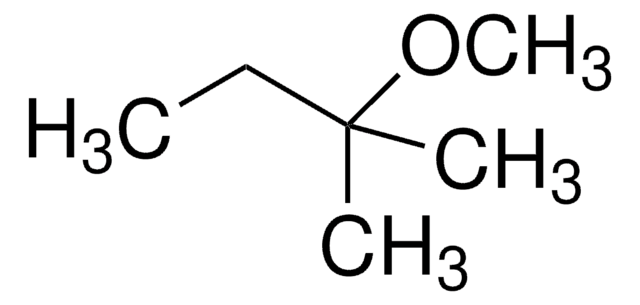8.41873
tert-Butyl ethyl ether
for synthesis
Synonym(e):
tert-Butyl ethyl ether
About This Item
Empfohlene Produkte
Dampfdruck
173 hPa ( 25 °C)
Qualitätsniveau
Assay
≥95.0% (GC)
Form
liquid
Wirksamkeit
>2000 mg/kg LD50, oral (Rat)
>2000 mg/kg LD50, skin (Rabbit)
Expl.-Gr.
1.23-7.7 % (v/v)
bp
71 °C/1013 hPa
mp (Schmelzpunkt)
-97 °C
Übergangstemp.
flash point -19 °C
Löslichkeit
12 g/L
Dichte
0.74 g/cm3 at 20 °C
Lagertemp.
2-30°C
InChI
1S/C6H14O/c1-5-7-6(2,3)4/h5H2,1-4H3
InChIKey
NUMQCACRALPSHD-UHFFFAOYSA-N
Anwendung
- Quantitative structure-property relationship modeling: tert-Butyl ethyl ether is used in physiologically based kinetic modeling, showcasing its role in quantitative structure-property relationship (QSPR) studies and Monte Carlo simulations, which are crucial for predicting the behavior of chemicals in biological systems (Yamada et al., 2022).
- Automatic monitoring of VOCs: It is utilized in the development of an in-source helical membrane inlet with single photon ionization time-of-flight mass spectrometry, enhancing the automatic monitoring of trace volatile organic compounds in water, significant for environmental monitoring and safety (Li et al., 2019).
- Pharmacokinetic and toxicological research: The ether serves as a subject in the development and application of rat physiologically based pharmacokinetic (PBPK) models to elucidate kidney and liver effects induced by ethyl tert-butyl ether and tert-butanol, offering valuable insights into its safety and physiological impacts (Chiu et al., 2015).
- Environmental monitoring: It is also featured in research focusing on the determination of fuel ethers in water by membrane extraction ion mobility spectrometry, providing an efficient method for environmental monitoring of this compound in aquatic systems (Sillanpää et al., 2013).
- Exposure assessment: Research includes exposure assessment studies of ethyl tert-butyl ether among gas station workers and gasoline tanker truck drivers, emphasizing the importance of occupational safety and health standards in industries using this chemical (Omae et al., 2011).
Hinweis zur Analyse
Dichte (d 20 °C/ 4 °C): 0.737 - 0.744
Identität (IR): entspricht
Signalwort
Danger
H-Sätze
Gefahreneinstufungen
Flam. Liq. 2 - STOT SE 3
Zielorgane
Central nervous system
Lagerklassenschlüssel
3 - Flammable liquids
WGK
WGK 1
Flammpunkt (°F)
-2.2 °F - closed cup
Flammpunkt (°C)
-19 °C - closed cup
Analysenzertifikate (COA)
Suchen Sie nach Analysenzertifikate (COA), indem Sie die Lot-/Chargennummer des Produkts eingeben. Lot- und Chargennummern sind auf dem Produktetikett hinter den Wörtern ‘Lot’ oder ‘Batch’ (Lot oder Charge) zu finden.
Besitzen Sie dieses Produkt bereits?
In der Dokumentenbibliothek finden Sie die Dokumentation zu den Produkten, die Sie kürzlich erworben haben.
Unser Team von Wissenschaftlern verfügt über Erfahrung in allen Forschungsbereichen einschließlich Life Science, Materialwissenschaften, chemischer Synthese, Chromatographie, Analytik und vielen mehr..
Setzen Sie sich mit dem technischen Dienst in Verbindung.








